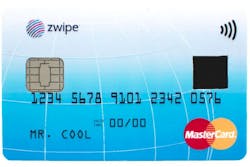Zwipe and MasterCard launch biometric contactless payment card
Given the number of high-profile data breaches in the retail sector over the past year, there has been a push within the industry to move away from the traditional swipe and sign method of payment at point-of-sale (PoS) terminals. The retail industry, for their part, has advocated for a move towards chip-and-PIN technology. Already widely used throughout Europe, chip-and-PIN technology uses payment cards with embedded chips inside that are inserted into a reader that also requires the customer to type in a unique PIN for the purchase to be validated. Just last week, President Barack Obama issued an executive order requiring cards issued by the government to have chip-and-PIN technology.
However, Zwipe and MasterCard have partnered to develop a payment card that offers a level of security beyond that of chip-and-PIN. The Zwipe MasterCard is the world’s first contactless payment card that features an integrated fingerprint sensor. The fingerprint data of the cardholder is stored directly on the card rather than in an external database. To make a purchase, the user activates the card with a fingerprint scan, which can then be used to make contactless payments with EMV (EuroPay, MasterCard and Visa)-compatible PoS terminals.
“Your identification is stored only on your card. The only time your (credit/debit card) is read is when you touch the fingerprint sensor on the card surface, so it’s like using an on and off button for your card,” said Kim Humborstad, founder and CEO of Zwipe.
The biometric authentication on the Zwipe MasterCard replaces the PIN entry, which enables cardholders to make payments of any amount, unlike other contactless payment cards currently available on the market.
“Our belief is that we should be able to identify ourselves without having to use passwords or PIN numbers. Biometric authentication can help us achieve this. However, our challenge is to ensure the technology offers robust security, simplicity of use and convenience for the customer,” said Ajay Bhalla, president of enterprise security solutions at MasterCard.
According to Humborstad, there are two banks currently piloting the Zwipe MasterCard, one of which is beta testing it for credit cards while the other is testing it for debit cards.
Humborstad said that retailers will not have to make any infrastructure changes to use the Zwipe MasterCard as long they have EMV-compatible terminals. More than 80 countries around the world have already adopted EMV and beginning in October 2015, retailers in the U.S. that do not support EMV will assume liability for fraudulent card transactions.
Although the country has lagged behind the rest of the world in making the migration to EMV, Humborstad said the initial interest they’ve seen for the Zwipe MasterCard in the U.S. has been promising.
“It is true that the U.S. market has been hesitant to introduce chip-and-PIN. We will need to learn how they will adopt biometrics over time, but initial interest from American banks shows promise, probably because it provides increased security and convenience at the same time,” added Humborstad.
Zwipe is now working on the next generation of its card that will be the same format as a standard card and designed to work with all payment terminals for release in 2015. This new card will harvest energy from the payment terminals without the need for a battery.
About the Author
Staff Reports
Editorial and news reports authored by the media team from Cygnus Security Media, including SecurityInfoWatch.com, Security Technology Executive magazine and Security Dealer & Integrator (SD&I) magazine.
